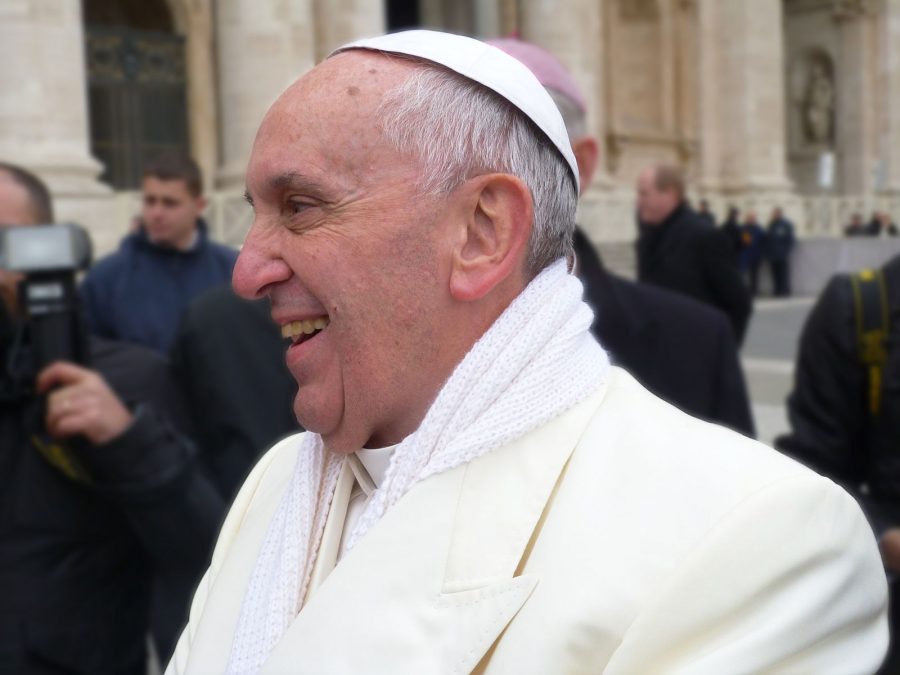A Justification of the “Gender Theory” Berate
On Sunday, October 2, during a return flight to Rome from his trip to Georgia and Azerbaijan, the Pope was questioned again about the “gender theory” which he had in August called terrible and referred to as “ideological colonization.” Consequently, his speech prompted an uprising of dissatisfaction and disapproval from the LGBT community. In an attempt to reword his statements and better convey his intentions, Pope Francis stated that he did not condemn the transgender community. Rather, he believes that the best course of action is to guide transgender individuals rather than castigate them.
After journalists questioned the Pope about his speech, he cited two examples to justify his reformulated thesis. First, he explained his encounter with a French father who had told him about his 10 year old son who desired to become a girl after learning about transgenderism in school textbooks. To emphasize his disapproval towards academically teaching gender freedom to children, he reaffirmed that he finds it “against natural things,” and says that “It’s one thing if a person has this tendency and also changes sex. It’s another thing to teach this in school to change mentalities. This is what I call ‘ideological colonization.’” In opposition to that statement, Francis DeBernardo, executive director of New Ways Ministry, a Catholic LGBTQA+ advocacy group, argued that “The Pontiff’s remarks are further evidence that church officials need desperately to educate themselves about the lives and experiences of LGBTQA+ people. Nobody chooses a gender identity. They discover it.”
The objective of Pope Francis’ second example was to appease the angered masses and more competently transmit his intentions. He commented about visiting a trans man and his wife, he praised a bishop who had spent time with the couple, and he criticized another bishop who had yelled “You will go to hell!” to them from across the street. He wished to convey that, although religious teachings disapproved of the act of same-sex attraction, the solution would most definitely not be to eliminate the queer community. “We must be attentive, not saying all are the same. Every case: Welcome it, accompany it, study it, discerning and integrating. This is what Jesus would do today,” said the Pope.
Pope Francis finally clarified his position to Catholic News: “I want to be clear, it is a moral problem. It is a problem. A human problem. And it must be resolved the best one can — always with the mercy of God, with the truth” and “always with an open heart.” I accompanied them; I helped them draw closer to the Lord, although some couldn’t, but I never abandoned them.” However, his point of view still did not completely satisfy the LGBTQA+ community. Rev. Rodney McKenzie Jr. of the National LGBTQ Task Force states the following:
When Pope Francis made his now famous ‘who am I to judge’ remarks, LGBTQ people were hopeful for real change in the Roman Catholic church. Now millions of people are deeply hurt by what Pope Francis has said about transgender and gender nonconforming people, which reveals a profound lack of knowledge and empathy. We urge the pontiff to educate himself about the realities of transgender people’s lives and to welcome and affirm transgender and gender nonconforming people rather than reject and dehumanize them (McKenzie).
Although Pope Francis claims that the transgender community should be treated respectfully, he still addresses transgenderism as a form of “disease” by referring it to as “problem” that ought to be “resolved”. After giving his short speech, he begged the reporters to not write down that “the Pope blesses trans.” Perplexingly, this raises the question of whether he wholeheartedly meant everything he had stated about the trans community.
Sources: CNN, Advocate, LBGTQ Nation

As this year becomes the end of her 3-year adventure at The Talon (and, less importantly, at Graded), Helen has set a few goals for this journalistic institution,...








